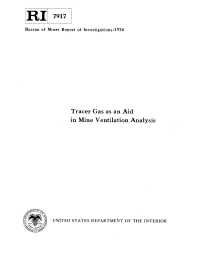Mining Publication: Tracer Gas as an Aid in Mine Ventilation Analysis
Original creation date: January 1974
The Bureau of Mines has successfully used sulfur hexafluoride (SF6) as a tracer gas to measure mine air flows under conditions where conventional methods have failed. SF6 was employed experimentally to measure accurately recirculation of return into intake air caused by leakage through an old stoped area, to check for potential leakage from an adjacent mine, to trace 10,000 cfm of "lost" air from an intake airway, and to measure transit air time through uranium mines. It proved useful as a means of accurately measuring airflow volumes in airways of large cross section and very low flow velocity and in determining the recirculation resulting from underground cooling plants.
Authors: ED Thimons, FN Kissell
Report of Investigations - January 1974
NIOSHTIC2 Number: 10000743
U.S. Department of the Interior, Bureau of Mines. Report of Investigations 7917, NTIS No. PB234051, 1974; :1-17
See Also
- Demonstration of Safety Plugging of Oil Wells Penetrating Appalachian Coal Mines
- Experimental and Modeling Investigation of the Effect of Ventilation on Smoke Rollback in a Mine Entry
- In-depth Survey Report: Control Technology for Environmental Enclosures - The Effect of Wind Speed Upon Aerosol Penetration Into an Enclosure at Clean Air Filter, Defiance, IA
- Investigation into the Practical Use of Belt Air at US Longwall Operations
- Investigation of induced recirculation during planned ventilation system maintenance
- Laboratory Testing To Quantify Dust Entrainment During Shield Advance
- Measurement of Airflow in a Simulated Underground Mine Environment Using an Ultrasonic Anemometer
- Sonic Anemometer Airflow Monitoring Technique for Use in Underground Mines
- Sulfur Hexafluoride as a Mine Ventilation Research Tool - Recent Field Applications
- Three Coal Mine Ventilation Studies Using Sulfur Hexafluoride Tracer Gas
- Content source: National Institute for Occupational Safety and Health, Mining Program


 ShareCompartir
ShareCompartir
